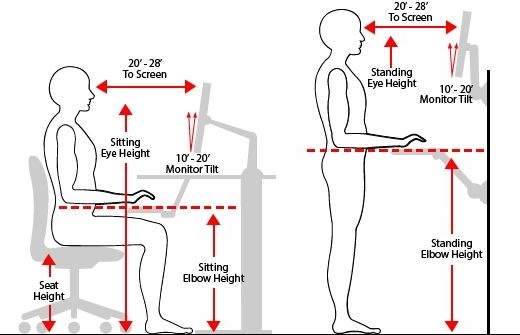The height of a height-adjustable desk should be set based on the user's ergonomic needs to ensure comfort and reduce strain. Guidelines to determine the correct height for both sitting and standing positions:
Sitting Position

-
Elbow Height:
-
When seated, your elbows should be at a 90-degree angle or slightly greater when your hands are on the desk.
-
Your forearms should be parallel to the ground.
-
Typical Desk Height: For most people, this is about 25 to 30 inches (63 to 76 cm) from the floor.
-
Monitor Height:
-
The top of your monitor should be at or slightly below eye level.
-
Your screen should be about an arm's length away from you.
-
Feet Placement:
-
Your feet should be flat on the ground or on a footrest, with your knees at a 90-degree angle or slightly greater.
Standing Position
-
Elbow Height:
-
When standing, your elbows should again be at a 90-degree angle or slightly greater when your hands are on the desk.
-
Your forearms should be parallel to the ground.
-
Typical Desk Height: For most people, this is about 35 to 47 inches (89 to 119 cm) from the floor.
-
Monitor Height:
-
The top of your monitor should be at or slightly below eye level.
-
Your screen should be about an arm's length away from you.
-
Feet Placement:
-
Stand with your weight evenly distributed on both feet.
-
Use an anti-fatigue mat for added comfort if standing for extended periods.
Adjusting Your Desk
-
Use a Measuring Tape:
-
Measure from the floor to your elbows while sitting and standing to find your optimal desk height.
-
Fine-Tune:
-
Adjust your desk height and monitor position until you feel comfortable and aligned.
-
Ensure your wrists are in a neutral position, not bent up or down, when typing.
Summary
-
Sitting Desk Height: Approximately 25 to 30 inches (63 to 76 cm) from the floor.
-
Standing Desk Height: Approximately 35 to 47 inches (89 to 119 cm) from the floor.
-
Monitor Height: Top of the monitor at or slightly below eye level.
Remember, these are general guidelines, and individual preferences and body dimensions may require adjustments. The key is to maintain a comfortable and ergonomic position to reduce strain and promote better posture.
